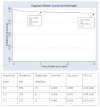High survival and treatment success sustained after two and three years of first-line ART for children in Cambodia
- PMID: 20302672
- PMCID: PMC2851581
- DOI: 10.1186/1758-2652-13-11
High survival and treatment success sustained after two and three years of first-line ART for children in Cambodia
Abstract
Background: Long-term outcomes of antiretroviral therapy (ART) in children remain poorly documented in resource-limited settings. The objective of this study was to assess two-and three-year survival, CD4 evolution and virological response among children on ART in a programmatic setting in Cambodia.
Methods: Children treated with first-line ART for at least 24 months were assessed with viral load testing and genotyping. We used Kaplan-Meier analysis for survival and Cox regression to identify risk factors associated with treatment failure.
Results: Of 1168 registered HIV-positive children, 670 (57%) started ART between January 2003 and December 2007. Survival probability was 0.93 (95% CI: 0.91-0.95) and 0.91 (95% CI: 0.88-0.93) at 24 and 36 months after ART initiation, respectively. Median CD4 gain for children aged over five years was 704 cells/mm3 at 24 months and 737 at 36 months. Median CD4 percentage gain for children under five years old was 15.2% at 24 months and 15% at 36 months. One hundred and thirty children completed at least 24 months of ART, and 138 completed 36 months: 128 out of 268 (48%) were female. Median age at ART initiation was six years.Overall, 22 children had viral loads of >1000 copies/ml (success ratio = 86% on intention-to-treat-analysis) and 21 of 21 presented mutations conferring resistance mostly to lamivudine and non-nucleoside reverse transcriptase inhibitors. Risk factors for failure after 24 and 36 months were CD4 counts below the threshold for severe immunosupression at those months respectively. Only two out of 22 children with viral loads of >1000 copies/ml met the World Health Organization immunological criteria for failure (sensitivity = 0.1).
Conclusions: Good survival, immunological restoration and viral suppression can be sustained after two to three years of ART among children in resource-constrained settings. Increased access to routine virological measurements is needed for timely diagnosis of treatment failure.
Figures




Similar articles
-
Positive outcomes of HAART at 24 months in HIV-infected patients in Cambodia.AIDS. 2007 Nov 12;21(17):2293-301. doi: 10.1097/QAD.0b013e32828cc8b7. AIDS. 2007. PMID: 18090277
-
Long-term virological outcome in children receiving first-line antiretroviral therapy.AIDS Res Ther. 2018 Nov 26;15(1):23. doi: 10.1186/s12981-018-0208-9. AIDS Res Ther. 2018. PMID: 30477526 Free PMC article.
-
Outcome of patients on second line antiretroviral therapy under programmatic condition in India.BMC Infect Dis. 2015 Nov 14;15:517. doi: 10.1186/s12879-015-1270-8. BMC Infect Dis. 2015. PMID: 26572102 Free PMC article.
-
Factors associated with the failure of first and second-line antiretroviral therapies therapy, a case control study in Cambodian HIV-1 infected children.BMC Res Notes. 2016 Feb 5;9:69. doi: 10.1186/s13104-016-1884-y. BMC Res Notes. 2016. PMID: 26850410 Free PMC article.
-
[Consensus document of Gesida and Spanish Secretariat for the National Plan on AIDS (SPNS) regarding combined antiretroviral treatment in adults infected by the human immunodeficiency virus (January 2012)].Enferm Infecc Microbiol Clin. 2012 Jun;30(6):e1-89. doi: 10.1016/j.eimc.2012.03.006. Epub 2012 May 23. Enferm Infecc Microbiol Clin. 2012. PMID: 22633764 Spanish.
Cited by
-
[Impact of antiretroviral therapy on the biological profile of HIV positive children followed-up at Yaounde University Hospital in Cameroon].Pan Afr Med J. 2015 Feb 19;20:159. doi: 10.11604/pamj.2015.20.159.4677. eCollection 2015. Pan Afr Med J. 2015. PMID: 26113902 Free PMC article. French.
-
Adherence to antiretroviral therapy (ART) during the early months of treatment in rural Zambia: influence of demographic characteristics and social surroundings of patients.Ann Clin Microbiol Antimicrob. 2012 Dec 28;11:34. doi: 10.1186/1476-0711-11-34. Ann Clin Microbiol Antimicrob. 2012. PMID: 23270312 Free PMC article.
-
The Diagnosis of HIV Infection in Infants and Children.Iran J Pathol. 2016 Spring;11(2):89-96. Iran J Pathol. 2016. PMID: 27499768 Free PMC article. Review.
-
Fuzzy-multidimensional deep learning for efficient prediction of patient response to antiretroviral therapy.Heliyon. 2019 Jul 20;5(7):e02080. doi: 10.1016/j.heliyon.2019.e02080. eCollection 2019 Jul. Heliyon. 2019. PMID: 31372545 Free PMC article.
-
[Treatment failure in children infected with HIV in routine follow-up in a resource-limited setting in Cameroon].Pan Afr Med J. 2013 Jun 30;15:80. doi: 10.11604/pamj.2013.15.80.2754. eCollection 2013. Pan Afr Med J. 2013. PMID: 24171063 Free PMC article. French.
References
-
- Janssens B, Raleigh B, Soeung S, Akao K, Te V, Gupta J, Vun MC, Ford N, Nouhin J, Nerrienet E. Effectiveness of highly active antiretroviral therapy in HIV-positive children: evaluation at 12 months in a routine program in Cambodia. Pediatrics. 2007;13:1134–1134. doi: 10.1542/peds.2006-3503. - DOI - PubMed
Publication types
MeSH terms
Substances
LinkOut - more resources
Full Text Sources
Medical
Research Materials
Miscellaneous

